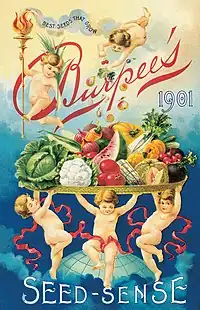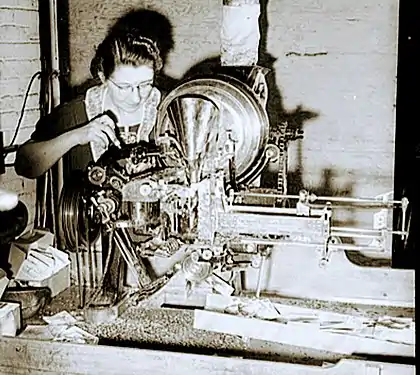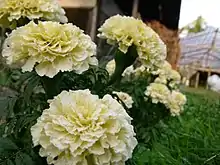 | |
| Industry | Gardening |
|---|---|
| Founded | 1876 |
| Founder | Washington Atlee Burpee |
| Headquarters | |
Key people |
|
| Products | Seeds, plants, and supplies for home gardening |
| Website | burpee |
Burpee Seeds and Plants, officially W. Atlee Burpee & Co., is an American seed and plant company that was founded by Washington Atlee Burpee in Pennsylvania in 1876.[1]
History
Early years (1876–1915)
W. Atlee Burpee & Company was founded in 1876 by Washington Atlee Burpee in Philadelphia, Pennsylvania, after starting a mail-order chicken business in 1876. The company expanded to selling garden seeds, farm supplies, tools and hogs after customers began asking for seeds they had grown in their native farms. In 1888, the family farm, Fordhook Farm in Doylestown, Pennsylvania, was established as a family farm and crop field trials after Burpee began traveling to Europe to collect seeds which needed to be adapted to North American climates.[2][3] The farm was likely the first experimental test field station in the United States. In 1900, distant cousin Luther Burbank visited the farm inspiring him to create his own experiments. He later created additional research stations, including in California in 1909, to test seeds.[4][5] By the turn of the century, Burpee's had created one of the largest mail and freight businesses of the time.[6]
_(20501247072).jpg.webp) W. Atlee Burpee & Co. (1884)
W. Atlee Burpee & Co. (1884)_(20501427622).jpg.webp) Seed warehouse operations (1893)
Seed warehouse operations (1893) Burpee's farm annual (1886)
Burpee's farm annual (1886) Burpee seed catalog (1901)
Burpee seed catalog (1901)
Expanding the company (1915–1970)

The direction of the company began to change with the death of its founder in 1915, when his son, David Burpee, inherited the company.[7] David was interested in victory gardens and was an early promoter of the concept during World War I.[8] He also prioritized in flowers and initiated several flower hybridization breeding programs. Geneticists also began to modify the genes of seeds using x-rays and colchicine.[8]
Under his leadership, the advertising and catalog also improved. The advertisements began to include full-color advertising to include Burpee's strengths of reliability of seeds using the motto "Burpee's Seeds Grow" and leader in the industry while the catalog was compact, arranged by category, and easy to find the order form. Any information not included in the catalog was sent to the customer requesting it in a handwritten letter. The catalog's sales averaged $4 per order (equivalent to $67.5 today).[7]: 38 Various artists illustrated the catalog including Paul de Longpre and Alois Lunzer.[9]
After Burbank's death in 1926, Burpee acquired the rights to his experiments but no notable vegetables or flowers were to come from Burbank's work.[5] In 1949, Burpee introduced its 'Big Boy' tomato hybrid which quickly became its best seller.[3]
New ownership (1970–present)

In 1970, David Burpee sold the company to General Foods for $10 million.[8][10] In 1974, Burpee moved from its north Philadelphia location to its current headquarters at 300 Park Avenue in Warminster, Pennsylvania. SEPTA extended its Warminster Line commuter rail to Warminster, the train station being opposite Park Avenue from Burpee's headquarters. In the 70s, the company introduced seed-starting kits for beginners, an innovation in the seed industry.[5]
In 1979, the company was acquired by ITT. David Burpee remained as a consultant until his death in June 1980.[11] In 1981, experimentation and seed production left Fordhook Farm.[3]
In the 1980s, gardens had begun to shrink in size from an average of 600 square feet to 325 square feet while chain stores began selling a better selection of plants to their customers who preferred plants over seeds. These market changes and mismanagement by ITT led Burpee's sales to slump, and the company was purchased for $15 million by new investors McKinsley & Co. in 1987.[11][10]
In 1991, the Burpee company was acquired by George Ball, Inc., a diversified horticultural family business. The new leadership diversified the business by selling new and unusual varieties; more plants than seeds; opening its own retail stores in 2000; and utilizing its web store to boost business. Jonathan Burpee, the founder's grandson, was the last Burpee family member to work for the company.[11]
In 1998, Ball purchased the family farm, where notable varieties such as Iceberg lettuce and Big Boy tomato were bred, to renovate and establish the property as a horticultural center. The seeds Burpee produces are almost exclusively grown in California.[12]
In March 2019, James Mattikow was named the company's president and CEO.[13]
White marigold

In 1919, David Burpee began working to hybridize the marigold to overcome its limited colors, scrawniness, and late blooming flowers. It was at this time that he first had the idea of a white marigold competition but held off on it due to his belief that the hybridization would be unsuccessful.[8]
In its 1954 catalog, W. Atlee Burpee & Co. first advertised a competition for the development of the first white marigold flower, offering $10,000 to any gardener whose efforts produced a flower deemed to be pure white. Twenty-one years later, in 1975, the prize was awarded to 67-year-old Alice Vonk of Sully, Iowa, who received $100 the previous year as one of six gardeners nationwide whose marigolds came closest to being white.[14][15][16][17][18] Vonk kept seeds from the lightest flowers in her garden each season, replanting for over two decades before achieving a pure white marigold that measured 2.5 inches in diameter. Her entry in the 1975 edition of the contest topped 8,200 other entrants and produced what was then described as the "costliest flower ever".[14] Burpee's branded the flower as "Burpee's Best Whites."[5]
By 1960, the odorless flower was the best-selling flower in the United States.[8]
References
- ↑ "Company History". Burpee.
- ↑ "W. Atlee Burpee -- Seedsmen.org". www.saveseeds.org. Retrieved November 14, 2019.
- 1 2 3 Washington, Julie (September 15, 2016). "Burpee's Fordhook Farm: A visit to one of the world's leading seed breeding companies (photos)". Cleveland.com. Retrieved November 14, 2019.
- ↑ "2 Oct 1976, Page 11 - The Daily Intelligencer at Newspapers.com". Newspapers.com. Retrieved November 21, 2019.
- 1 2 3 4 "Garden genius David Burpee, 83, still crusades for marigold". The Boston Globe. August 29, 1976. p. 169. Retrieved November 22, 2019.
- ↑ Coulter, Lynn (December 1, 2012). Gardening with Heirloom Seeds: Tried-and-True Flowers, Fruits, and Vegetables for a New Generation. UNC Press Books. ISBN 9781469608716.
- 1 2 Printers' Ink Monthly. Romer Publishing Company. 1919.
- 1 2 3 4 5 "D.W. Burpee, 87, the Leader Among Seedsmen Dies". The Philadelphia Inquirer. June 25, 1980. pp. 1, 7. Retrieved November 21, 2019.
- ↑ "A flowering of commercial illustration will be on exhibit". The Philadelphia Inquirer. October 13, 2000. p. 73. Retrieved November 22, 2019.
- 1 2 "Back to its roots". The Courier-Journal. September 27, 1987. p. 70. Retrieved November 22, 2019.
- 1 2 3 "Burpee plants seeds in retail, Internet businesses". Daily Press. June 25, 2000. p. 89. Retrieved November 22, 2019.
- ↑ "Fordhook Farm is central to Burpee's plans for new growth". The Boston Globe. May 20, 2004. p. 21. Retrieved November 22, 2019.
- ↑ Staff (March 25, 2019). "Jamie Mattikow named President and CEO of W. Atlee Burpee". Seed World. Retrieved November 14, 2019.
- 1 2 "Sully Woman's Life Unchanged After Producing Prize Marigold," Pella Chronicle, Pella Iowa, September 10, 1975, page 16.
- ↑ "White Marigold Earns $10,000 for State Woman". The Beaver County Times. August 30, 1975 – via Google News Archive.
- ↑ "Reward is $10,000 for white marigold". The Free Lance–Star. August 30, 1975 – via Google News Archive.
- ↑ "Widow grows $10,000 flower". Evening Independent. August 29, 1975 – via Google News Archive.
- ↑ "White Marigold Found After 56 Years". Sarasota Herald-Tribune. September 28, 1975 – via Google News Archive.
External links
- Official website
- Burpee catalog cover gallery
- Dennis Werner Collection of Seed Catalogs 1883-2013, contains approximately 90 annual publications from W. Atlee Burpee & Co